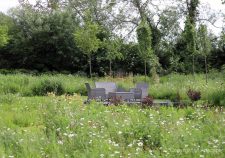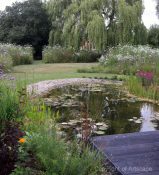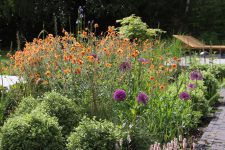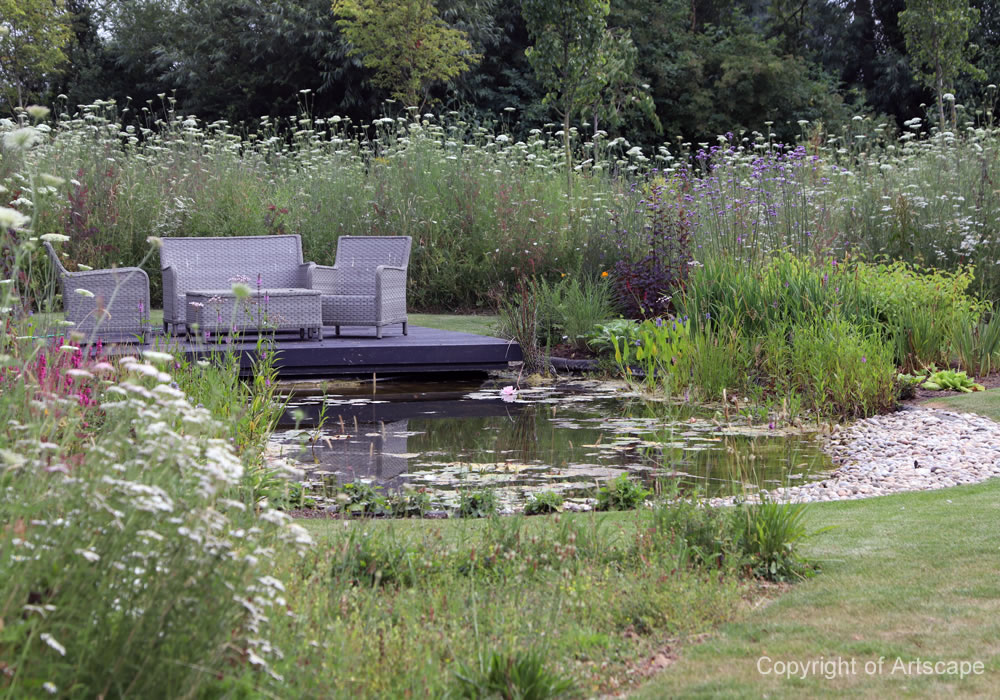Rewilding and the trend for informal, natural, wildlife-friendly gardens continues to grow. Many homeowners in Berkshire and Buckinghamshire are choosing to have a natural garden design to improve biodiversity with planting that will attract and protect pollinators, birds, and other wildlife. The added attraction of a natural garden is that it needs less water and less maintenance too. However, it’s important to know that even an informal garden with a more relaxed, untamed look needs to be well designed, landscaped and planted.
 What is a natural garden?
What is a natural garden?
A natural garden has an informality achieved through soft planting schemes which provide year-round interest. It should also be sustainable and wildlife friendly. Nothing in the natural style garden should look too rigid, ordered or over-stylised.
But it should still be designed otherwise it could look messy and chaotic.
The best natural gardens look authentic and are spaces that make you feel good to spend time in. The pleasing appearance comes from repetition, colour and texture. The best option for wildlife is a garden that retains a mix of both cultivated areas and wilder areas. Defined areas and permanent features will achieve a balanced look, while well-chosen flowering plants will bring beauty to the garden each season and entice pollinators. And natural reclaimed materials such as stone and brick will give the garden character.
Put in a pond
 The best natural gardens have a wildlife pond. A pond is a simple and effective way to support native amphibians, such as frogs and newts, by providing them with a place to breed and shelter. One side of the pond should be shallow and gradually sloped for access; and ramps can be made from natural materials like stones and logs. Don’t introduce fish in your wildlife pond as they can have an adverse impact on amphibians and aquatic insects.
The best natural gardens have a wildlife pond. A pond is a simple and effective way to support native amphibians, such as frogs and newts, by providing them with a place to breed and shelter. One side of the pond should be shallow and gradually sloped for access; and ramps can be made from natural materials like stones and logs. Don’t introduce fish in your wildlife pond as they can have an adverse impact on amphibians and aquatic insects.
Plant for pollinators
To encourage wildlife, choose plants that provide year-round nectar, pollen, seeds and berries, such as hawthorn, holly, apple and rowan trees. If you want to create a more natural garden and improve its biodiversity, plant a mix of flower-rich species to encourage pollinating insects.
Relish rotting
Rot and decay are part of the natural cycle of returning nutrients to the ground, so don’t be too tidy. Allow fallen twigs and leaves to rot down into the soil and boost your garden’s eco system. Leaves and branches on the ground provide a habitat for insects and hedgehogs too.
Let your grass grow
Don’t mow too often and allow a specific area of your lawn to grow longer. Wildlife needs this variety to flourish. You could also consider a meadow growing native grasses and wildflowers together. Also, where possible, do include a wild patch for brambles, honeysuckle and nettles in your garden design.
 Artscape natural garden design
Artscape natural garden design
At Artscape, we design, landscape and plant gardens with nature in mind. This means choosing plants and sustainable materials that suit the conditions of properties in Berkshire and Buckinghamshire and support the natural environment.
If you are planning a beautiful new natural scheme for your garden in Berkshire or Buckinghamshire, please get in touch with us today at Artscape to discuss your project. Our specialist wildlife garden design and build services can include natural ponds, wildflower meadows, hedges, water features, living green walls and all kinds of sustainable landscaping.




